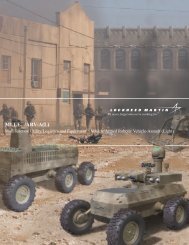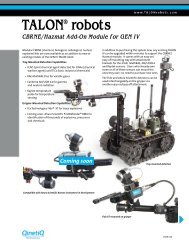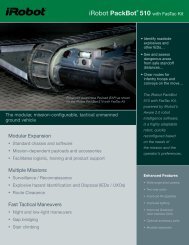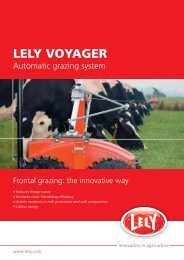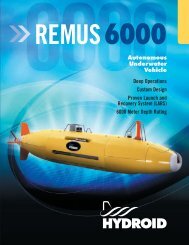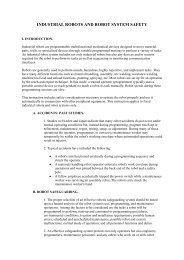Adept Quattro s650H Robot
Adept Quattro s650H Robot User's Guide - Asimo.pl
Adept Quattro s650H Robot User's Guide - Asimo.pl
- No tags were found...
You also want an ePaper? Increase the reach of your titles
YUMPU automatically turns print PDFs into web optimized ePapers that Google loves.
Mounting Frame<br />
NOTE: More specifications for the sample frame are provided in<br />
Section 7.6.<br />
Any robot’s ability to settle to a fixed point in space is governed by the forces, masses, and<br />
accelerations of the robot. Since “every action has an equal and opposite reaction”, these<br />
forces are transmitted to the robot frame and cause the frame and base of the robot to<br />
move and possibly vibrate in space. As the robot system works to position the tool flange<br />
relative to the base of the robot, any frame or base motion will be “unobservable” to the<br />
robot system, and will be transmitted to the tool flange. This transmitted base motion will<br />
result in inertial movement of the tool flange mass, and will cause disturbance forces to be<br />
introduced into the robot control system. These disturbance forces cause “work” to be<br />
done by the robot servo control system which may result in longer settling times for robot<br />
operations.<br />
It is important to note that, even after the system reports the robot to be fully settled, the<br />
tool flange will still be moving by any amount of motion that the suspended base of the<br />
robot may be experiencing.<br />
Frame Orientation<br />
The sample robot frame design is stiffer in one direction than the other. This is to<br />
accommodate conveyor belt applications where the robot is moving with much more<br />
acceleration across a conveyor belt than along it. The conveyor should generally be<br />
aligned so that the belt travel is along the robot World Y-axis, and the mid-height frame<br />
members cross the belt at a 90° angle. The across-the-belt dimension of the frame should<br />
be minimized to get the best performance of the robot in that direction. While this frame<br />
design assumes a 1.8 m across-the-belt frame dimension, a 1.5 m dimension would offer<br />
increased stiffness and possibly increased robot performance at high accelerations and<br />
payloads. The mid-height horizontal members are important to the frame stiffness, and<br />
should be located as close to the belt as possible.<br />
For applications requiring high accelerations along the direction of belt travel,<br />
consideration should be given to strengthening the frame in that direction.<br />
Frame Construction<br />
Typically, the frame is constructed of welded steel members. Hygiene-sensitive<br />
applications may call for stainless steel fabrication, with care taken to seal up all possible<br />
voids and grind smooth all weld joints. For other applications, it may be suitable to<br />
manufacture the frame of carbon steel and paint the resulting assembly. The frame design<br />
presented here is based on a stainless steel construction using 10 mm thick members. It<br />
may be reasonable to use a reduced thickness for carbon steel assemblies. Some customers<br />
may choose to use tubular members, or turn horizontal members at 45° angles to facilitate<br />
water runoff from the flat frame surfaces.<br />
<strong>Robot</strong>-to-Frame Considerations<br />
The <strong>Quattro</strong> has a moderately-complex mounting requirement due to the nature of the<br />
parallel-arm kinematics and the need to minimize the robot size and mass. Figure 7-5 on<br />
page 86 shows the inner arm travel and how it may encroach on the robot mounting<br />
points. The design suggested here uses transition pieces to allow for butt welds and<br />
mating interfaces where there will be no protruding surfaces to collect contamination.<br />
This mounting design results in a natural frequency of about 90 Hz for just the robot<br />
<strong>Adept</strong> <strong>Quattro</strong> <strong>s650H</strong> <strong>Robot</strong> User’s Guide, Rev A 39



